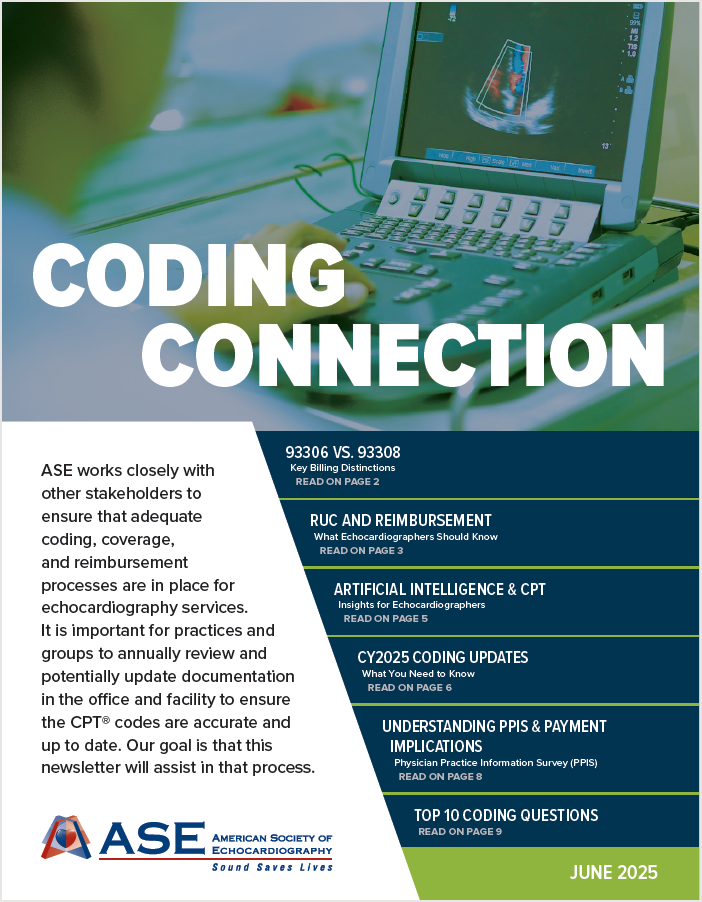October 31, 2022
The Honorable Ami Bera, M.D. The Honorable Larry Bucshon, M.D.
U.S. House of Representatives U.S. House of Representatives
The Honorable Kim Schrier, M.D. The Honorable Michael C. Burgess, M.D.
U.S. House of Representatives U.S. House of Representatives
The Honorable Earl Blumenauer The Honorable Brad R. Wenstrup, D.P.M.
U.S. House of Representatives U.S. House of Representatives
The Honorable Bradley Scott Schneider The Honorable Mariannette Miller-Meeks, M.D.
U.S. House of Representatives U.S. House of Representatives
Dear Members of Congress:
The American Society of Echocardiography (ASE) appreciates the opportunity to respond to your request for feedback on actions Congress could take to stabilize the Medicare physician payment system, including reforming the current payment structure so it supports a system that provides greater value to patients and to physicians. The ASE is the Society for Cardiovascular Ultrasound Professionals™️. ASE is the largest global organization for cardiovascular ultrasound imaging serving physicians, sonographers, nurses, veterinarians, and scientists and as such is the leader and advocate, setting practice standards and guidelines for the field. Since 1975, the Society has been committed to advancing cardiovascular ultrasound to improve lives.
The increasing cost to physician practices to provide care without adequate inflationary updates, along with the new threat of annual cuts to the Medicare physician payment conversion factor due to the restraints of budget neutrality, point to the need to re-evaluate the physician payment system, and, specifically, the Medicare Access and CHIP Reauthorization Act (MACRA). The COVID-19 pandemic also uncovered weaknesses in our nation’s healthcare infrastructure and payment systems that have led to significant healthcare consolidation further threatening patient care in many areas.
On behalf of its members and the patients they serve, ASE is grateful for your outreach to healthcare providers, advocacy organizations and others for feedback on the current state of MACRA and associated payment mechanisms and ideas for reform. ASE is pleased to provide its perspective on the following topics:
- Medicare Physician Payment
- Barriers to Timely Care for Medicare Beneficiaries
- Medicare’s Quality Payment Program
Medicare Physician Payment
Inflationary Updates and Payment Adequacy
When MACRA was passed, it replaced the sustainable growth rate (SGR) formula and ended roughly 12 years of repeated congressional intervention to prevent Medicare physician payment cuts that were triggered by the SGR when overall physician costs exceeded target expenditures that were pegged to growth in the national economy.
In its place, MACRA was intended to create payment stability and provide incentives to physicians for performing efficiently while delivering high-quality care. MACRA statutorily set modest Medicare physician payment updates, starting at 0.5 in 2015 through 2019, and 0 percent for 2020 through 2025. For 2026 and beyond, it is 0.75 percent for eligible alternative payment model (APM) participants and 0.25 percent for all others.
Over a 12-year period, during which the SGR was in effect, annual payment increases to physicians averaged about 0.3 percent, while the cost of running a medical practice increased about 3 percent annually.[1] The fact is that physicians are still paying for nearly two decades of insufficient payment updates. Taking inflation in practice costs into account, Medicare physician payment plunged 20 percent from 2001 to 2021.
A fundamental and critical step that Congress can take to create payment stability is to provide, beginning in 2023, a positive annual physician payment update that reflects inflation in practice costs. It is indisputable that consolidation — vertical, horizontal, and cross-market — results in increased costs to the healthcare system which outweigh any suggestion that consolidation can lead to better care coordination and efficiency. In Medicare, vertical consolidation has been met with calls for site-neutral payment policies that are often focused on driving rates to levels that are unsustainable and that contributed to physician practices selling out to hospitals/health systems in the first place. It is time Congress understand the impact of consolidation and the increasing number of physicians who are choosing to forego independent practice for hospital employment — payment inadequacy and instability and regulatory burden.
Because it will take time to secure a massive, badly needed overhaul of the Medicare physician payment system, immediate action is needed to stop harmful cuts that will take effect on January 1, 2023 and to ensure future payment stability. ASE urges Congress to take action before the end of this year to:
- stop the scheduled 4.42 percent budget neutrality cut to 2023 Medicare physician fee schedule payments;
- end the statutory annual freeze and provide a Medicare Economic Index update for 2023; and
- waive the 4 percent PAYGO sequester triggered by passage of the American Rescue Plan Act.
Barriers to Timely Care for Medicare Beneficiaries
There are a number of contributors to physician burnout, but prior authorization is one of the biggest causes. Medicare Advantage (MA) and other private insurance plans routinely subject diagnostic tests and procedures to cumbersome authorization processes that lead to substantial treatment and diagnosis delays. Echocardiographers are not given rules or indications of how these authorizations will be adjudicated. Prior authorization protocols unnecessarily delay patient care and shift costs onto providers who are uncompensated for the administrative time and staff required for authorization and appeals.
Denials of prior authorization requests are raising concerns about beneficiary access to medically necessary care. A report from the Office of the Inspector General found, upon examination of a random sample of prior authorization denials by MA plans, that 13 percent met Medicare coverage rules and likely would have been approved for these beneficiaries under original Medicare.[2] It is time that MA plans be held to some level of accountability when medically necessary appropriate treatment is withheld or delayed.
With nearly half the Medicare eligible population enrolled in a MA plan, legislation is urgently needed to reduce the burden of prior authorization on physician practices, as well as to improve patient outcomes by preventing delays in care and minimizing the number of patients who forego diagnostics and treatment altogether when it is denied or subjected to a lengthy appeal.
ASE endorses the Improving Seniors’ Timely Access to Care Act (S. 3018 / H.R. 3173) as a way to increase transparency and streamline prior authorization in the MA program and protect timely access to care for Medicare patients and calls upon Congress to pass the legislation this year.
Medicare’s Quality Payment Program
A goal of MACRA was to improve care for Medicare patients by shifting the payment system from volume to value. MACRA set up the Merit-based Incentive Payment System (MIPS) as a pathway to alternative payment models (APMs). The law lowered payment updates over time for MIPS participants to incentivize their move to APMs. For most specialties, including echocardiography, MIPS is a path to nowhere because of a lack of specialty APMs. As a result, physician practices are investing in MIPS participation to avoid payment penalties, but participation requires significant practice resources with little return on those investments amidst questions about whether MIPS even accurately captures quality or is incentivizing improvements in care delivery.
A recent published study on the costs for physician practices to participate in MIPS found physicians, clinical staff, and administrative staff together spent 201.7 hours annually on MIPS-related activities at a per-physician, per-year cost of $12,811.[3] According to a survey conducted by the Medical Group Management Association, 90 percent of physician practice respondents said positive payment adjustments did not cover the costs of time and resources spent preparing for and reporting under MIPS.[4]
MIPS Value Pathways
Recently, CMS has begun a programmatic shift from MIPS to MIPS Value Pathways (MVPs). The MVP concept is a CMS iteration of the “Accountable Clinician Episodes” (ACE) concept developed and put forth to CMS by the AMA and other medical societies, including the ASGE. The intent behind the ACE option was to award MIPS credit to clinicians who engage in performance activities that satisfy the requirements of multiple MIPS performance categories (“multi-category credit”). For example, if a clinician reported quality measures electronically via a Qualified Clinical Data Registry (QCDR) that interfaces with their EHR, the clinician would receive full credit for the Promoting Interoperability category. The ACE concept was also envisioned as a long-run performance-based model or as a stepping stone for clinicians between participation in separate, unrelated MIPS measures and participation in an APM or Advanced APM.
MVPs, as currently designed, mirror many of the flaws in MIPS. If CMS moves ahead with MVPs as currently structured, it will be impossible to convince physicians that MVPs are anything more than a rebranding of MIPS with little-to-no benefit to physician practices or their patients.
Participation Incentives
In addition to making MIPS participation more cohesive and, ideally, more meaningful, ASE asks Congress to re-examine the incentive structure for participation.
MACRA’s $500 million exceptional performance bonus expires with payment year 2024 (performance year 2022). Because of the budget neutral redistributive nature of MIPS, there is very little return on investment, and therefore incentive, for MIPS participation. Budget neutrality is the fundamental flaw of the entire MIPS program – it needs winners and losers. A physician or physician practice can fully engage and still lose. Ideally, financial incentives for participation in MIPS would help practices build the infrastructure to move to APMs when they become available. ASE asks Congress to allocate additional funds to extend the exceptional performance bonus beyond the 2024 payment year.
Future MVPs should have a better participation incentive structure. Physicians who participate in MVPs should also be held harmless from downside risk for at least the first two years of participation while they gain familiarity with a model that is more consistent with an APM and while CMS collects and shares data about whether MVPs are meeting their goal to improve quality and reduce unnecessary costs for the Medicare program and beneficiaries.
MIPS Performance Threshold
CMS should lower the MIPS performance threshold to a degree that avoids penalizing one-third of MIPS eligible clinicians.[5] Sec. 101(c)(6)(D) of the statute requires CMS to set the performance threshold at the mean or median of the composite performance scores for all MIPS eligible professionals, and CMS proposes to maintain it at 75 points for the 2023 performance period.
As opposed to a pre-set formula, CMS is in a better position to determine each year whether physicians are ready to move to an increased performance threshold given the agency has access to all the previous year’s performance data. CMS may also decide to establish different thresholds for small and large practices.
Physician Access to Timely, Actionable Data
Physicians should be held accountable for the costs that are within their control and should have access to their claims data analysis to identify and reduce avoidable costs. Though Congress has taken action to give physicians access to their claims data, to this day physicians do not receive timely, actionable feedback on their resource use and attributed costs in Medicare. What is a lower-cost physician doing differently from a high-cost physician? For example, is it that they are better at care coordination? If we do not know the answer, we cannot achieve the goal of reducing avoidable costs and overuse. Physicians and specialty societies need access to their claims data analysis to identify variations in spending that are not accounted for by differences in patient needs and to eliminate unnecessary costs.
Furthermore, CMS needs to provide more detailed, specialty-specific and site-of-service specific breakdowns of MIPS performance data in the Experience Report or accompanying Appendix. The Public Use File (PUF) is not usable for national medical specialty societies that are evaluating opportunities for improvements in quality, cost, Promoting Interoperability, and Improvement Activities, nor in developing MVPs. The 2020 QPP PUF provides some site-of-service information, such as whether the physician bills in an Ambulatory Surgery Center or is considered hospital-based, but it is too limited.
Conclusion
Over time, underlying problems with the physician payment system and challenges with the QPP, and MIPS in particular, have revealed themselves much to the frustration of physicians and with a negative impact on patient care. Many of the issues outlined above cannot be addressed administratively and, therefore, require congressional action. We appreciate that reaching consensus on solutions to these problems will not be an easy task. However, there is consensus on actions that Congress can take immediately that will better allow MACRA to fulfill its purpose of increasing value in the U.S. healthcare system.
Should you have questions or require additional information, please contact Irene Butler, ASE’s Vice President of Health Policy and Member Relations, at [email protected].
Sincerely,
Stephen Little, MD, FASE
President, American Society of Echocardiography
[1] Parke DW 2nd. The SGR Fix: Was It? Mo Med. 2015 Nov-Dec;112(6):408-9. PMID: 26821437; PMCID: PMC6168105.
[2] Some Medicare Advantage Organization Denials of Prior Authorization Requests Raise Concerns About Beneficiary Access to Medically Necessary Care. U.S. Department of Health and Human Services, Office of Inspector General. April 2022. https://oig.hhs.gov/oei/reports/OEI-09-18-00260.pdf
[3] Khullar D, Bond AM, O’Donnell EM, Qian Y, Gans DN, Casalino LP. Time and Financial Costs for Physician Practices to Participate in the Medicare Merit-based Incentive Payment System: A Qualitative Study. JAMA Health Forum. 2021;2(5):e210527. doi:10.1001/jamahealthforum.2021.0527
[4] MGMA Annual Regulatory Burden Report – 2022. https://www.mgma.com/practice-resources/government-programs/mgma-annual-regulatory-burden-report-2022
[5] Centers for Medicare & Medicaid Services CMS–1770–P
Publish date
November 1, 2022
Topic
- Advocacy
- Archived Correspondence
Related News

Member News

Member News

Member News

